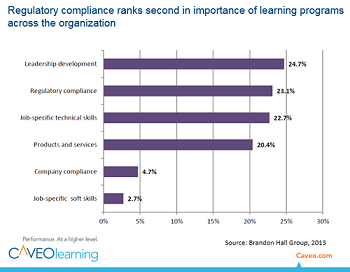Posted by Caveo Learning ● January 29, 2015
Compliance Training—Critically Important, Too Often an Afterthought
 Compliance training is the most important responsibility of a learning organization, both in terms of legal responsibility as well as operational efficiency, and yet it often gets treated as an afterthought—given short shrift with rote, boring training.
Compliance training is the most important responsibility of a learning organization, both in terms of legal responsibility as well as operational efficiency, and yet it often gets treated as an afterthought—given short shrift with rote, boring training.
Too many organizations still cling to a simple read-and-agree format for their compliance training, but taking that approach comes with real danger. It's no longer acceptable to merely present regulators with training records and signed documents as a way of proving compliance—regulatory auditors have begun interviewing and quizzing workers on the manufacturing floor about these issues. If your workforce isn't prepared for that degree of compliance interrogation, it can put the entire operation at risk.
Executives need to buy into the fact that compliance training is just as important as other types of training initiatives, if not more so. That effort begins by changing the paradigm that compliance training has to be monotonous and painfully boring.
 A 2013 survey of learning leaders ranked regulatory compliance second, behind only leadership development, in importance among the various types of training. Nearly a quarter (23.1%) of learning leaders said regulatory compliance training is the most important aim of the learning & development function, beating out such crucial topics as job-specific technical skills, product training, and soft skills. In fact, if we group regulatory compliance and company compliance together, the topic of compliance training is the single most important training topic.
A 2013 survey of learning leaders ranked regulatory compliance second, behind only leadership development, in importance among the various types of training. Nearly a quarter (23.1%) of learning leaders said regulatory compliance training is the most important aim of the learning & development function, beating out such crucial topics as job-specific technical skills, product training, and soft skills. In fact, if we group regulatory compliance and company compliance together, the topic of compliance training is the single most important training topic.
It can be argued that the consequences for a poorly executed compliance training program would be greater and more immediate than those of an ineffective leadership development program.
Taking all of this into consideration, plus the fact that two-thirds of companies in the survey said that the need to demonstrate learning compliance to an external agency was either very or critically important, the crucial role compliance plays is evident. However, compliance training does not get the same kind of attention as other training programs when it comes to design, development, or delivery, according to the survey. It is often seen as dry, boring, and almost as a necessary evil.
In 2014 alone, OSHA introduced a staggering 75,000 pages of new regulations. How can you ensure that your company is compliant with this avalanche of regulations?
First of all, compliance training must go beyond just "checking the box." Everyone thinks of compliance training as something you do in January and February, and then forget about the rest of the year. It has to be more integrated into the core of the business, sustained and reinforced throughout the year.
It's time to rethink the approach to compliance training.
 Overhauling the compliance training approach starts with changing the mindset of instructional design experts. They need to approach compliance training as business thinkers, creating learning solutions that are timely, relevant, meaningful, and actionable.
Overhauling the compliance training approach starts with changing the mindset of instructional design experts. They need to approach compliance training as business thinkers, creating learning solutions that are timely, relevant, meaningful, and actionable.
Take a value-based approach to creating compliance training. Since compliance training is both a legal and operational necessity, use those sunk-cost resources and that captive learning audience to create engaging training that goes beyond mere knowledge transfer, facilitating knowledge application for true impact on business performance.
There are a few basic tactics for developing value-based compliance training:
- Review the compliance topic to ensure it is a training opportunity.
- Determine terminal learning objectives.
- Consider the target audience and locations.
- Look for areas that may affect job or task performance.
- Design and develop using creative and proven instructional design methodologies.
This is easier said than done, of course, and instructional designers will no doubt wonder, "How can I make compliance training more interesting?" Consider interactive approaches like simulations and case study scenarios. Place the learner in a compliance scenario and offer multiple options for action, then deliver real-world feedback. Then offer a post-initiative assessment involving management.
Compliance issues need to be made relevant and meaningful to employees.
Compliance tends to be rather dense with legalese, so it's important to bring the topics into a real-world context with meaningful impacts. In other words, don’t just spit regulatory terminologies back at them. At the same time, take care not to change the regulation's technical meanings in the course of trying to make it more learner-friendly.
Here are some examples of learner-friendly, value-based compliance training that Caveo has implemented within client training programs:
Another big challenge in creating effective compliance training involves the so-called "gray areas"—those situations for which there may not be a black-or-white answer. In those cases, it may make sense to offer a spectrum of possible responses, allowing the learner to select multiple potentially acceptable responses and then delving into the complexities within the feedback and debriefing.
Compliance training is only a small part of a greater ecosystem that needs to be created to ensure compliance in the policies and procedures. It takes everyone in the organization actively participating in order to realize the true benefits of a compliance program. It's worth keeping in mind that senior leaders, managers, and employees each have different objectives in a compliance training program:
| Senior Leaders | Managers | Employees |
|
|
|
There is a change management component to improving compliance training, as well, and that involves around adjusting the attitudes and outlooks of executives toward compliance training. As sponsors of the initiative for better compliance training, executives need to stop viewing government regulations as a punitive measure, and instead start thinking of compliance as a driver for more efficient and effective business practices.
Doing compliance training right can cost a bit more up front, but the expense pales in comparison to the cost of doing compliance training poorly.
In 2012, OSHA conducted 93,000 inspections across the country and found 200,000 violations and levied nearly $200 million in fines. As of February 2013, the Federal Trade Commission had collected $2.68 billion in penalties from persons involved in the financial crisis. And since 2009, pharmaceutical companies have agreed to pay over $13 billion to resolve DOJ fraudulent practices allegations.
Moreover, compliance is no longer only a concern of the business—the federal government in recent years has begun penalizing individuals, as well. The Sarbanes-Oxley Act and newer laws can carry penalties for compliance violations of prison sentences of up to five years and fines of up to $250,000. Individuals are now personally exposed to compliance issues, lending a renewed urgency and seriousness to compliance training broadly.
Not all benefits of compliance training are obvious.
There are many business benefits of compliance training that may not be immediately obvious. For example, effective safety training has can mean fewer worker days lost and higher production. Certainly, the workers benefit from improved health and wellness, but they also gain greater job security and more opportunities for promotion as a result of a more profitable company.
Some other "hidden" benefits of effective compliance training can include:
- Better workplace alignment. It sets the tone for expectations, standards, and personal and professional obligations to customers and shareholders.
- Stay on up to date on trends. Some industries that have a high frequency of change and risk being out of step with the latest industry changes.
- Streamlined employee processes. Workers can better calibrate expectations and act within an appropriate framework for making business decisions.
- Greater standardization. Improved conformity across the organization results in efficiently leveraging existing processes and checkpoints.
- Heightened transparency. When management and employees are on the same page, it results in improved organizational intelligence and ultimately better decisions.
Caveo can help your organization deliver outstanding compliance training that is cost-effective, engaging, and which introduces operational efficiencies to boost the bottom line. Watch our compliance training webinar below, and then contact us today!
Topics: Metrics & Measurement, Instructional Design, Compliance Training

